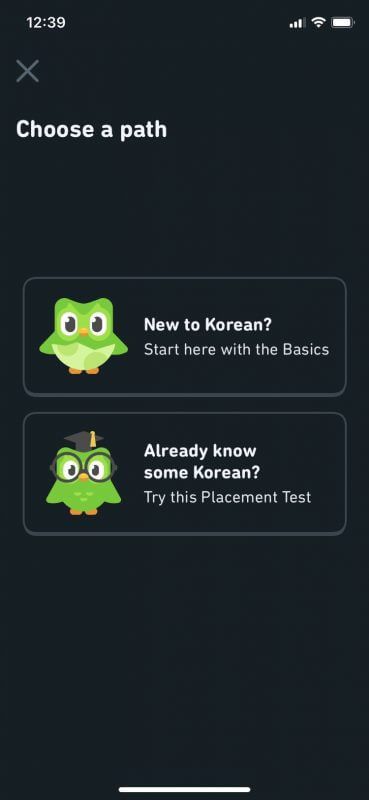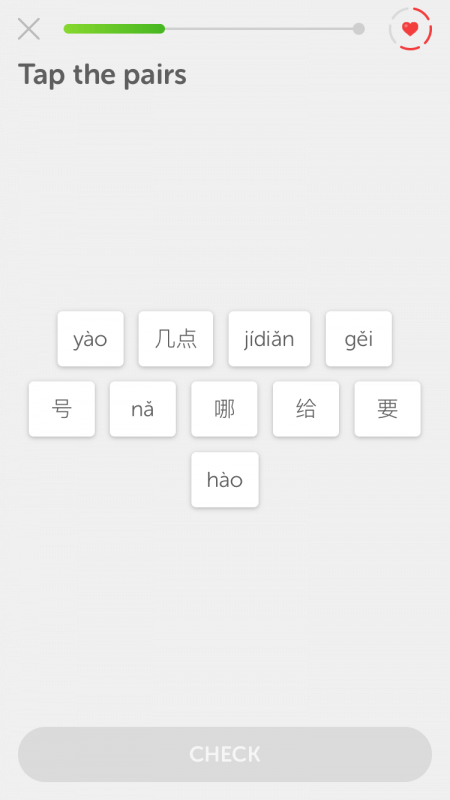Duolingo Chinese Review - Can I Really Learn Chinese with Duolingo? (2023)
Duolingo Chinese Complete & Honest Review – Where Can Duolingo Take Me & Should I Believe The Hype?
Duolingo Rating 8.5/10
Duolingo is a great, fun, and accessible app for beginners – intermediate speakers who need motivation learning a language and don’t have that much time. Duolingo won’t take you to language fluency and there is a limit to how much you can learn.
Duolingo is one of the biggest names out there when it comes to learning a language. But is the Duolingo Chinese version a good way to learn Chinese?

We take a deep dive into Duolingo in this Duolingo review. Here, we concentrate on learning Chinese with Duolingo.
We look at various different aspects to conclude where Duolingo can really take you – and whether it’s worth bothering to even try to use the app.
Duolingo teach users from around the globe a host of languages. In fact they pride themselves on being one of the only apps to actively teach dying languages like Gaelic and Hawaiian.
Knowing this already tells us Duolingo are big hitters.
Compared to some of the apps we review, they are without doubt, near the top in times of size.
However, the potential drawback to Duolingo is, because they teach so many languages, perhaps the quality is not so strong.
Plus, can their teaching techniques really lead you to language fluency?
Is it a case of quantity over quality?
Let’s see if that is true as we review Duolingo’s Chinese language.
(We have done a long and comprehensive review. Feel free to skip ahead to the chapters you need by clicking the links below).
BONUS || Other Great Resources
Duolingo Review Chinese || Introduction & Key Stats
Duolingo Review Chinese || Pros and Cons
Duolingo Review Chinese || Price (Premium subscription, worth it?)
Duolingo Review Chinese || Duolingo Comparisons
Duolingo Review Chinese || Getting Started with Duo
Duolingo Review Chinese || Using Duolingo (how it works)
Duolingo Review Chinese || What it DOES and DOESN’T Teach
Duolingo Review Chinese || How can Duolingo improve?
Duolingo Review Chinese || Can I become fluent in Chinese?
Duolingo Review Chinese || Chinese Topics Taught on Duolingo
Duolingo Review Chinese || Should I download Duolingo Chinese?
Duolingo Review Chinese || What Other Languages Can I Learn?
Duolingo Review Chinese || Downloading Duolingo
Duolingo Review Chinese || FAQs
Learning Chinese Key Resources
So, you want to learn Chinese?
Before we start – and, spoiler alert – Duolingo will not take you to fluency in Chinese. No matter how good the app may or may not be, it’s not the only resource you will have to use. And as a beginner, there are some things missing from Duolingo that you will need from the get-go.
Duolingo might best suit beginners in terms of Chinese learning (we’ll get onto that below) but it does miss out on a few key things.
In order to be able to learn Chinese, it’s important to have a grasp on the basics.
We’ll leave some resources here we think Duolingo is missing for those just starting to learn Chinese and wanting some key background information on the Chinese language and to get a good base to study from.
Pinyin/Writing Systems in Chinese
Chinese Characters Guides (Hanzi)
- Ultimate Guide to Chinese Characters (+ alphabet)
- 100 Most Common Chinese Characters
- Traditional Chinese Character List (100 most common)
Chinese Tones
Basic Chinese Guides
Learn Chinese Guides
- Learn Chinese FREE PDF book (from LTL)
- A Guide to Free Learning Chinese Resources (including Instagram?!)
- Free online trial class with Flexiclasses
- A Guide to Learning Chinese Online
Duolingo Review Chinese // Duolingo Introduction (+ key stats)
Duolingo Key Stats
| Name | Duolingo |
| Description | “With our free mobile app or web and a few minutes a day, everyone can Duolingo. Learn 30+ languages online with bite-size lessons based on science.” (Duolingo) |
| Website | https://www.duolingo.com/ |
| No. of Languages Offered | 30+ |
| Price | Free / $7 per month |
BOTTOM LINE || Duolingo is a great, fun, and accessible app for beginners who need motivation learning a language and don’t have that much time to commit in large blocks. More serious learners may find Duolingo a tad slow, tedious, and inadequate when it comes to various areas such as grammar and actual use.
Duolingo Introduction
Duolingo use fun, memorable sentences to teach you the basics of a variety of languages. They’re a fun company – one of those companies you look at and just know they’d be great fun to work for.
Just have a look at any of their social media channels to know that their marketing department look forward to work every morning!
They really capitalise on the bizarre sentences they’re most famous for. Although, I personally don’t know how much use it is knowing ‘my rabbit wears my sister’s shoes’ in Chinese.
Nevertheless, it’s all good fun.
WHAT? The app takes you through levels in Chinese where it tests your vocabulary, listening, and grammar skills. It does this by introducing vocabulary (both written and sound) and requiring you to form sentences.
HOW? You and the Duolingo Owl work your way through different levels that let you pass once you are able to complete the level. Levels are locked unless you have completed the previous levels.
WHEN? It will remind you daily to practice (even just 5 minutes, come on!) and its push notifications are pretty effective in motivating you to keep up your ‘streak’.
WHERE? Duolingo’s structure makes it possible to learn Chinese on the go on your morning commute. The app is one of the best designed out there and very accessible.
WHO? Anyone can use Duolingo, from children to adults! It has an age of 4+ rating on the app store. Its ease of accessibility combined with humour reminds me of Disney films – fun for all the family!
Duolingo Review Chinese // Duolingo Chinese Pros and Cons
| Duolingo Pros | Duolingo Cons |
|---|---|
| It’s free | Health feature |
| Simple, clean design | Nothing about tones |
| Great for beginners | No content for the upper intermediate/advanced users |
| Motivational notifications | No real explanation about Hanzi/Pinyin and their relationship |
| Ideal for using on a commute | Limited prospect of fluency |
Duolingo is a fun, cool, and modern app that helps you to learn a language in a very accessible way. But it may not be the best for more serious language learners, and certainly won’t get you to fluency.
Duolingo Review Chinese // Duolingo Price (Premium subscription, worth it?)
Is Duolingo Free?
Thankfully yes. What’s more, Duolingo does not restrict your content exposure on the free version like many apps do.
A frustrating feature of many apps is that once you’ve completed, let’s say an hour’s worth of study, you are then blocked…
“SIGN UP FOR MORE”
The bain of so many of us!
Duolingo does not do this. It restricts you in other ways which we’ll come to later, BUT, the fact remains, you can complete the Duolingo Chinese course without having to spend a penny.
Great news!
Duolingo Premium Subscription
How much does Duolingo cost?
You can get most of Duolingo’s content for free (thanks Duo!).
But for unrestricted usage, you can consider the subscription.
| Duolingo Subscription | Price (USD$) |
|---|---|
| Monthly | $7 |
| Annual | $84 |
Duolingo Review Chinese // Duolingo Comparisons
(Other popular Chinese language learning apps)
| Language Learning App | Monthly | Annually | Lifetime |
|---|---|---|---|
| Memrise | $8.49 | $59.99 | $119.99 |
| Mondly | $9.49 | $39.99 | $89.99 |
| Drops App (includes Scripts by Drops) | $14.49 | $142.99 (annually for two years) | $174.99 |
| Italki | N/A (pay per lesson) | N/A (pay per lesson) | N/A (pay per lesson) |
| Duolingo | $7 | $84 | N/A |
| HelloTalk | $6.99 | $45.99 | $175.00 |
| Busuu | from $9.99 | from $69.96 | N/A |

LingoDeer Review (2025) – One of the Most Complete Chinese Learning Apps
LingoDeer App Review: Should I Start Using LingoDeer this 2025? LingoDeer Review: 9.5/10With an intuitive interface and engaging exercises, LingoDeer is one of the few apps that really gets it right, succeeding in offering a complete, strong and effective set…
Duolingo Review Chinese // Getting Started with Duo
Let’s walk you through how to get the most out of Duolingo Chinese and how Duolingo works.

Upon signing into Duolingo for the first time you select your language and then you are good to go!
In this review we’ll be focusing, of course, on the Duolingo Chinese course.
The user interface is sharp, yet simple.
It’s almost timeline-like, with the levels getting more advanced as you scroll down.
To reach the more advanced levels you have to unlock them by passing the previous levels.
Luckily if you have some knowledge of the language already you don’t have to start from the beginning.
As you can see from our screenshot, if you enter a language for the first time, you are faced with the following question:
- New to ____
- Already know some___
A great feature if you have a basis in Chinese (or any language of course) already.
From there, you are either placed at the start, or your set level and you are ready to roll.
Duolingo Review Chinese // Using Duolingo Chinese
When at your assigned level, you work your way down the list of lessons which are split into all kinds of categories which can range from the following:

… and so on.
As mentioned before, you cannot jump between all the lessons, you need to follow the order of lessons.
When you jump into a lesson itself, they are fairly quick-fire, normally offering multiple choice options, match the pairs or make a sentence.
TAKE NOTE – See the circle of hearts at the top right of the screenshot here.
This is your health. If you run out of health, you cannot continue. This is one of the shortcomings of the free version of Duolingo.
Therefore, five wrong answers and you’re out until they re-instate your health, which is normally a few hours later or the next day.
HOWEVER – there is a way around that. You can continue practicing rather than take official lessons.

By practising, you can re-earn the health you lost.
This means you can continue using the app no matter how many wrong answers you get.
The only difference is, by using the practice, they are not official lessons, meaning you don’t progress down the Duo timeline.
What I do like about Duolingo is their personal notifications which they use to motivate you.
Of course, they want you to use the app as much as possible. But I do find they really try and push you on with their little personal nudges.
For example, if you are on a 5-day streak using the app, they’ll drop you a little notification if it’s evening time on day 6 just to say…
“Quick – come and study your Chinese for the day to keep up your winning run. It’ll only take a few minutes…”
These of course are optional. Many people don’t like being swamped with push notifications, but I tried them with Duolingo Chinese and I found them more useful than intrusive.
Duolingo Review Chinese // What it DOES and DOESN’T Teach
Does Duolingo Teach Chinese Tones?
No. Duolingo does not explicitly teach you tones in Chinese. Instead, you can learn this by recognising them in the vocabulary you’ll learn.
It is however a good idea to at least understand the basic concept of Chinese tones before you attempt this.
Does Duolingo Teach Chinese Pinyin?
No, Duolingo does not explicitly teach you what pinyin is and how to use it. It does however utilise the pinyin system when it teaches you Chinese, so you can learn it as you go.
Again, it’s a good idea to at least understand the basics of this concept beforehand.
Did you know, that pinyin is not the only way to transcribe Chinese characters into phonetics? Taiwan do it differently…
Does Duolingo Teach Chinese Characters?
Yes and no. Duolingo uses Chinese characters as it teaches you Chinese. It combines these Chinese characters with their meanings in English, as well as the pinyin (how to pronounce it). It will then teach you how to use each of these Chinese characters in sentences.
It won’t, however, teach you the basics of these Chinese characters such as the radicals it’s made up of.
Does Duolingo Teach Chinese Radicals?
No, Duolingo won’t teach you Chinese radicals.
Radicals are the little parts that make up Chinese characters. They are important to at least understand and are a fundamental part of learning the Chinese language.
Duolingo really misses a trick by not starting at a more basic level for these fundamentals!
Does Duolingo Teach Chinese Grammar?
Yes, and no. You can get an insight into Chinese grammar by using the vocabulary you’ve learnt in sentences. However, Duolingo won’t explicitly teach you Chinese grammar.
Does Duolingo Teach Chinese Vocab & Phrases?
Pretty much the only thing Duolingo does! Duolingo will teach you Chinese vocabulary and how to use these in a sentence. It will teach you the pronunciation, the characters, and the pinyin (how it sounds) that goes with it. Using them in phrases will also give you a better understanding of the meaning and the usage too, as well as an insight into the grammar.
It’s not necessarily a bad thing that it’s all it does out of this list. These are important things. And it teaches them pretty well! But you should be aware learning vocab and usage in phrases will not be enough for absolute beginners.
You will need to systematically learn at least a little grammar, and understanding the concept of pinyin as well as the characters and how to build them up with radicals is paramount to a good foundation when learning Chinese.
For this, we’ve listed some useful resources at the top.
Duolingo Review Chinese // How can Duolingo improve?
Let’s look at some shortfalls and drawbacks of Duolingo.
- As mentioned above, the health is something that, although irritating to your journey, can be solved by either purchasing Duolingo, or practising.
- However, one thing Duolingo can improve on is the way it teaches, especially absolute beginners.
Duolingo Chinese doesn’t really teach you much about the characters you learn.
Does Chinese have an alphabet? Well, no it doesn’t, but Duolingo doesn’t tell you this in the lessons themselves.
你好 – what is this, how do you spell or say it? Although these questions are answered as you go on (or available in the tips section) I find it could ease beginners it a little easier within the lessons themselves.
- Chinese is nothing like any western language, and things need to be made clear at the start. The tones, the fact there is no alphabet, the fact pinyin is the romanization of Hanzi… etc.
I found the same when trying out the Japanese course. There are three alphabets in Japanese and there is no real description of why, and how they link. It can be a tad confusing when in the lesson.
Alongside watching a few videos on YouTube, you get it, but Duolingo needs an aid I feel. An app of this size shouldn’t in my opinion.
- Duolingo could improve so much by adding a traditional Chinese course, or a Taiwanese Chinese language section for those learning Chinese in Taiwan or for those interested in learning traditional characters. They’d just need to duplicate their content and change the characters over!
There are various courses and apps that have already started doing this. It’s a big shame Duolingo hasn’t started yet.
- Duolingo prides itself (and indeed has become quite the social media meme) for its bizarre sentences. These are hilarious sometimes and help to make it stick but other times you are just learning something bizarre that you could never actually use in any situation. Kind of like learning French or German in primary school; unless someone speaks to you like the app, you’re not actually going to be able to put much of the knowledge to good use.
In this respect, I see Duolingo as more of an app for less serious learners of a language that want to get the basics down and find it hard to be motivated otherwise. In reality, in terms of learning gains and quality, there are much better apps out there.
- The sentences are simple, as well as pretty rigid. For example, I tried the advanced levels out (as an advanced Chinese learner) and the sentences could have had slightly different meaning to the ones given. However, if I typed it in even slightly wrong, it would tell me I am incorrect.
Unfortunately, this is an issue with most of these types of learning apps. I suppose they have to get a balance between correcting you and having some flexibility!

Anki Review | The Best Flashcard App Ever? (FREE Decks Included)
LTL Taiwan School Director Alex gives us a full Anki review based on his own use of the app for the (many!) languages he is learning.
Duolingo Review Chinese // Can I become fluent in Chinese using Duolingo Chinese?
In a word, no.
However, there are a few things to note here.
I don’t believe any app, teaching any language allows you to go from zero to fluency. It just doesn’t work that way.
Duolingo is a great aid for helping boost your Chinese, make no mistake about that.
The app is clearly a good one and does a lot of things very well, but no app should boast language fluency when apps like Duolingo are used, in the large part, by the casual language learner, or by the learner who has a portfolio of a number of apps to aid their progress.
Duolingo Review Chinese // Chinese Topics Taught on Duolingo
There are 57 Chinese units taught on Duolingo. That’s a lot of units, and we’re not going to list them all here.
Nevertheless, the topics you can expect to be taught on Chinese Duolingo are;
- Asking someone’s name & greetings (2)
- Dates & days of the week (9)
- Getting around in a city (17)
- Discuss sports events (26)
- Giving directions (31)
- Hobbies (45)
- Communicating in an emergency (57)
Duolingo Review Chinese // Should I download Duolingo Chinese?
Duolingo works for some people, but not others.
There’s no doubt Duolingo does far more right than wrong. It’s a solid app for learning Chinese BUT it depends what your situation is.
Let’s give some examples of potential students:

- Student 1 – Speaks and reads to a HSK 4 level, wants to improve spoken Chinese further.
- Student 2 – Japanese native who is new to Chinese.
- Student 3 – Basic level, wants to improve all round Chinese.
- Student 4 – Advanced Chinese language learner.
See how the level and situation of every student can differ so widely.
Student 1 would not improve from downloading Duolingo as they are most likely too advanced and know the content already. Same goes for Student 4.
Student 3 would be the best example of a definite benefactor of using Duolingo Chinese.
Our Japanese native would also benefit but as Japanese uses an alphabet called Kanji, the same characters as Chinese, they might find elements of it a little easy, especially everything relating to the characters.
In summary…
If you are a beginner to Chinese, we absolutely recommend it. If you are beyond intermediate, you are best off heading to apps like Du Chinese or maybe the HSK Online app.
Check out our Best Apps to Learn Korean & Vietnamese!
See our FULL list of websites to learn Chinese.
Duolingo Review Chinese // What Other Languages Can I Learn?
Duolingo Languages
In this review, we concentrated on our learning Chinese on Duolingo experiences. But what other languages does Duolingo offer?
- English
- Arabic
- Bengali
- Czech
- Dutch
- Filipino
- French
- German
- Greek
- Hindi
- Hungarian
- Indonesian
- Italian
- Japanese
- Korean
- Polish
- Portuguese
- Romanian
- Russian
- Simplified Chinese
- Spanish
- Thai
- Traditional Chinese
- Turkish
- Ukrainian
- Vietnamese
Other
Duolingo also offers an app for learning your ABCs as well as Maths!
Duolingo Review Chinese // Downloading Duolingo
Downloading Duolingo is simple enough and due to its large size, it comes as no surprise that Duolingo is available to download on Apple’s App Store and Android’s Google Play.
Once you have the app ready on your phone, it’s time to get going!
Duolingo Review Chinese // FAQs
Where can I download Duolingo?
Duolingo from the App Store.
Duolingo from Google Play.
Can I get fluent in Chinese from Duolingo?
No. I don’t believe any app, teaching any language allows you to go from zero, to fluency. It just doesn’t work that way with apps. They should be used in a portfolio of other apps, or as aids to your daily learning.
Is Duolingo good for advanced Chinese learners?
No the app is mainly driven towards beginners of Chinese.
Can I learn other languages on Duolingo?
Yes Duolingo provides a host of languages to learn which include even Esperanto, Hawaiian and Gaelic.
What type of Chinese does Duolingo teach?
Duolingo uses standard Chinese you will find in mainland China. This is pretty clear by its use of the PRC flag on its ‘Chinese’ language section. This means simplified characters.
How long does it take to learn Chinese on Duolingo
Depending on what level you wish to get to in Chinese, you might have to spend a fair bit of time on Duolingo to actually get anywhere. Plus, using Duolingo alone to learn Chinese won’t get you to fluency.
Want more from LTL?
We offer a 7 day free trial to all new students where you can study Mandarin 24/7. Come and check it out free of charge and see what you think.
We also offer immersive Chinese courses in China. You can learn more about those here.
Sign up below and become part of our ever-growing community.
⭐ Download our free ebook, your starter pack of essential Mandarin learning resources!
Leave a comment below about Duolingo with your ratings! .












13 comments
I am sorry but the article did not help me or will help anyone that does know duolingo. Of course no app will make you fluent. French, for instance, has kind of 3.500 words, a very small amount compared to the number of words a fluent speaker should know. Duolingo is marvelous for the begginer. You can study in your own pace, learn the basics, a little vocabulary, a little grammar, enough to visit the country and not get lost, hire a bed in a hotel, buy a ticket, find a place. If you want more, you have to watch films, read books, talk. So, the soluction is to study in a course or take conversation classes.But these are expensive to learn the first words and constructions. Not only you have to pay as well as you have to have time for them and for going there and back, while you can study using Duolingo in your spare times, in the bus, while waiting for someone.
As for healph, I have no idea. I study every day, a planty of languages, and no lection becomes closed. Of course I have to repeat some lessons lots of times, just because some languages are so different that my brain requires time, effort and repetition. Mandarin is one, Arabic another, Greek yet another. But progress is made,
As for tones, yes, duolingo explains tones (read the tips) and has a lot of quizes in which you have to get the right tone to find the correct answer.
But, of course, no app can study for you, and their purpose is to teach you something of value. Duolingo does that. When I finish the course, not just get into the end, but with confidence, giving correct answers most of the time, then, and only then, I will worry about finding a teacher or a live course. But it is a long journey until then.
Hi Paulo,
Thanks for your detailed feedback, I really enjoyed reading what you had to say, this is the beauty of language learning and using apps - it's all about opinions.
Duolingo does many things well, as we stated, but as fervent language learners, we wish to point out how it can improve - and there is no doubting there are ways it can do this.
I think your summary that "Duolingo is marvelous for the begginer. You can study in your own pace..." is right on the money but personally, I maintain it can do more when talking about tones.
This is the first thing a Chinese language learner should be exposed too and because of the nature of the app, you don't really ever get the chance to talk and differentiate the tones like you can with other apps.
You are indeed right when you say Duolingo teaches us something of value. It's a market leader for a reason - but for sure, there are always things that can be improved to help all of us learners 🙂
Thanks again for your comment and taking the time to write it Paulo 🙂
LTL
Not a fan of Duo myself, leaves too many things open and focuses on number of language rather than quality
Thanks for your comment Neil
Good for beginners, otherwise don't bother
Thanks for commenting 🙂
Rubbish app lack of any explanations
☹️
They just updated the course and teach Pinyin and Hanzi now
Ooo much better!
Duolingo also changed the content a lot. Especially in the first units it seems. Looks like a there is a lot more colloquial stuff now, like 嗨 (Hi!), 哎呀 (Oh no!) or 汉堡包 (Hamburger). There still is a lot room for improvement on how the Learning-Hanzi feature is implemented, but nevertheless I feel that LTL should revise the review. (Learning Chinese with Duolingo for 3 years now but had prior knowledge on Pinyin and Hanzi, so I didn´t mind the lack of explanations much. I can imagine how difficult it must be to try to learn Chinese from scratch using Duo though.)
Great to know Renfield. We'll take a look 🙂
[…] truly understand Mandarin, using other resources is advised. This includes studying tones, characters, grammar, and conversation. For deeper […]